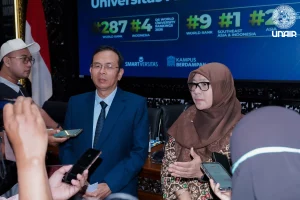UNAIR NEWS – Biofloc technology (BFT) is a cultivation system that can be an alternative due to limited land and water in the future. This system allows the use of high stocking density in a limited space without having to change the water. It was conveyed by Muhammad Hanif Azhar SPi MSi, a lecturer in Aquaculture, School of Health and Natural Sciences (SIKIA) UNAIR.
The lecturer, who is currently studying for a doctorate at the Turkish University, explained that the use of a biofloc system could significantly improve the quality of aquaculture water because the existing contaminants will be overhauled and converted into flocs that can be eaten by fish/fish. Therefore, he added that using the biofloc system does not require regular water changes as it can reduce pollutants in the water.
In addition, he revealed that the floc produced from the decomposition of organic waste in the biofloc system could be a source of nutrition for fish/shrimp. It is possible because the floc formed contains various kinds of microbes such as plankton, both phytoplankton and zooplankton, good bacteria associated with the extracellular polymeric substance.
“Wherein the compound contains several components such as proteins, carbohydrates, lipids, nucleic acids, and humic substances. Therefore, floc can be a source of nutrients to increase growth,” he said.
Continuing his presentation, Hanif revealed that several conditions must be met in forming a biofloc system, such as aeration and the content of carbon compounds (C) because heterotrophic bacteria play a major role in the biofloc system. Heterotrophic bacteria require carbon compound and oxygen as nutrients to grow and oxidize organic waste.
“In addition to an oxygen supply, aeration is also needed to keep the water mixed so that it does not cause sediment, which makes the formation of flocs not optimal,” he said in a sharing session on Saturday, April 30, 2022.
Hanif explained that for flocs to be formed in a biofloc system, the pond must have a carbon and nitrogen ratio (C/N ratio) = 10. In addition, in the media (water), there must also be a composition of biopolymer-producing bacteria that functions as a binding agent in the floc.
“Some of them are species such as Zooglea ramigera, Bacillus subtilis, Bacillus cereus, Pseudomonas alcaligenes, Spachratilus natans and Flavobacterium,” he said.
Some of these bacteria also produce Polyhydroxybutyrate (PHB) compounds which are intracellular polymers as a form of energy and carbon storage. He continued that this PHB can be a fish energy reserve, increase immunity, and increase growth.
In addition, Hanif also explained several other essential aspects of using biofloc systems, such as pH and temperature as limiting factors for metabolism and bacterial growth, and pond construction. He revealed that the construction of the pond in the biofloc system must allow for perfect mixing to be not optimal.
“Therefore, in general, the use of circular ponds is more often used in biofloc systems because it is able to maximize mixing. He continued that the construction of the pond must also have a sewer to reduce the floc if it is too dense,” he said. (*)
Author: Ivan Syahrial Abidin
Editor : Binti Q. Masruroh









